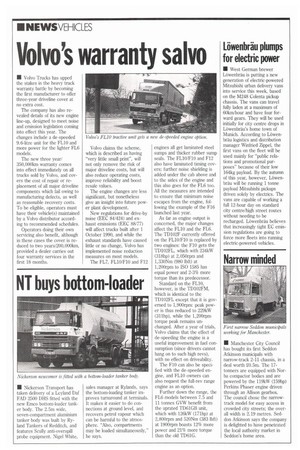Volvo's warranty salvo
Page 18

If you've noticed an error in this article please click here to report it so we can fix it.
• Volvo 'Frucks has upped the stakes in the heavy truck warranty battle by becoming the first manufacturer to offer three-year driveline cover at no extra cost.
The company has also revealed details of its new engine line-up, designed to meet noise and emission legislation coming into effect this year. The changes include a de-speeded 9.6-litre unit for the FL10 and more power for the lighter FL6 models.
The new three year/ 350,000km warranty comes into effect immediately on all trucks sold by Volvo, and covers the cost of repair or replacement of all major driveline components which fail owing to manufacturing defects, as well as reasonable recovery costs. To be eligible, operators must have their vehicle(s) maintained by a Volvo distributor according to recommended schedules.
Operators doing their own servicing also benefit, although in these cases the cover is reduced to two years/2(X),000km, provided a dealer carries out four warranty services in the first 18 months. Volvo claims the scheme, which is described as having "very little small print", will not only remove the risk of major driveline costs, but will also reduce operating costs, improve reliability and boost resale values.
The engine changes are less significant, but nonetheless give an insight into future power plant development.
New regulations for drive-by noise (EEC 84/424) and exhaust emissions (EEC 88/77) will affect trucks built after 1 October 1990, and while the exhaust standards have caused little or no change, Volvo has implemented noise reduction measures on most models.
The FL7, FL10/F10 and F12 engines all get laminated steel sumps and thicker rubber sump seals. The FL10/F10 and F12 also have laminated timing covers; further noise shielding is added under the cab above and to the sides of the engine and this also goes for the FL6 too. All the measures are intended to ensure that minimum noise escapes from the engine, following the example of the F16 launched last year.
As far as engine output is concerned, the major changes affect the FL10 and the FL6. The TD102F currently offered on the FL10/F10 is replaced by two engines: the F10 gets the TD102FL, which with 234kW (318hp) at 2,050rpm and 1,330Nm (980 lbft) at 1,200rpm to ISO 1585 has equal power and 2-3% more torque than its predecessor.
Standard on the FL10, however, is the TD102FM, which is identical to the TD102FL except that it is governed to 1,900rpm: peak power is thus reduced to 229kW (311hp), while the 1,200rpm torque peak remains unchanged. After a year of trials, Volvo claims that the effect of de-speeding the engine is a useful improvement in fuel consumption (since drivers cannot hang on to such high revs), with no effect on driveability.
The FIO can also be specified with the de-speeded engine, and FL10 owners can also request the full-rev range engine as an option.
Further down the range, the FL6 models between 7.5 and 11 tonnes GVW benefit from the uprated TD61GB unit, which with 126kW (171hp) at 2,800rpm and 520Nm (383 lbft) at 1900rpm boasts 12% more power and 21% more torque than the old TD61G.
















































































































































